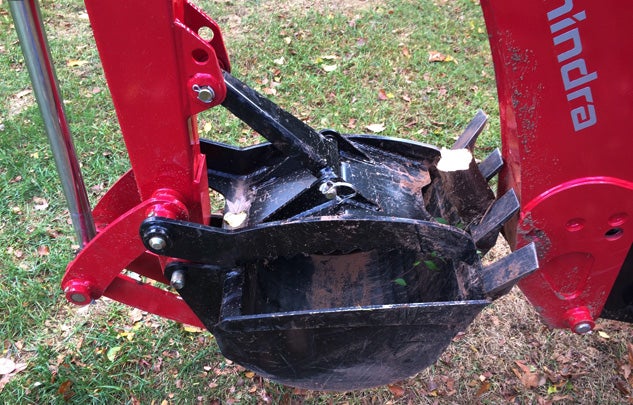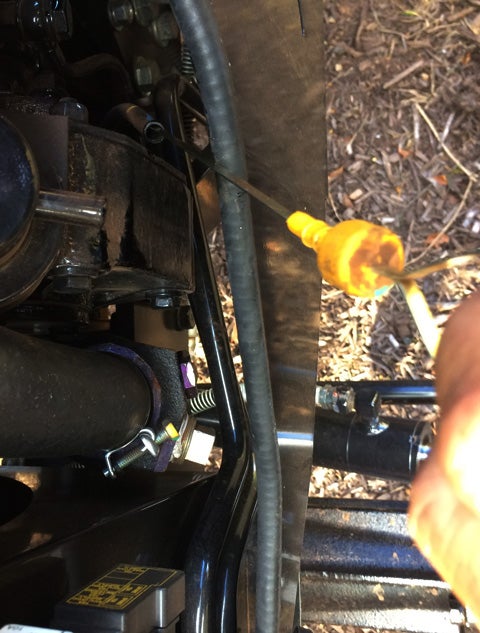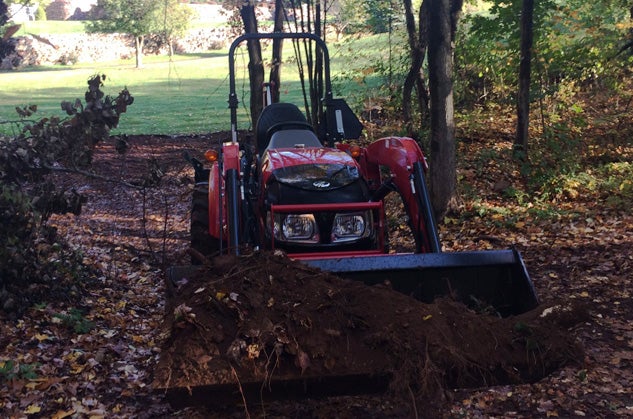.jpg)
Since our last report on the Mahindra 1538 TLB, we’ve haven’t logged as many hours on our test tractor as we thought we would. This certainly isn’t because of any deficiency, but more due to the fact that the tractor has been so productive for our projects, which have included moving dirt (a lot), grading, removing some pesky stumps, and relocating a number of large rocks and boulders. Still, between this midway impression piece and the wrap-up that will follow, we plan to ramp up the usage.
Right off the bat, the 1538 and the manufacturer-matched 1538L loader could easily use a wider/deeper bucket than the 57” one our test tractor was outfitted with. Certainly a 60” would be within its capabilities. Possibly even a 72” (check with your dealer first). Sweet spot shy of PTO rpm seemed to be around 1650-1700 rpm. At that speed the loader cycled nicely, fuel consumption was decreased, and sound levels were acceptable. We rechecked our dBA readings and found idle from the operator’s seat ran 79-85, while at the sweet spot rpm, the readings ran 85-90.
.jpg)
A lot of the Mahindra 1538 usage to-date has been with the 1538B backhoe. There, the 14” bucket seems ideally-sized. The thumb is an added nicety, though when not being used the shackle arm is best removed, as the thumb just gets in the way. To do so only requires the removal of two quick pins, but then you are left with the arm and pins to store someplace, and possibly misplace. And on the topic of pin storage, though the backhoe platform has two rubber ringed holes for the main boom up/down pin and the main boom side-to-side pin, there really isn’t any way to slip on the retainer underneath the platform and invariably end up getting put in your pocket or the tool box, which for our test tractor wasn’t installed.

We checked engine oil after the first operating hour and then again before each use. At 10 engine hours the oil was still totally clean and steady at the level the tractor was delivered at. To check the oil does require tilting the hood guard (rotating two quick pins) and then opening the hood (on a single gas strut). The space between the loader arms (bucket at ground level) is a little tight, but even our tester with the largest hands had no problem accessing the dipstick.
2016 Mahindra 1538 TLB Long Term Review: Part 1
 |
Firing up the Mahindra engine proved to be a non-event no matter the temperature. The engine always started immediately after cycling the glow plugs and was always a smokeless affair. However, the engine at the sweet spot (mentioned above) did have a slight vibration or buzz the operator could feel at the steering wheel, foot platform, seat etc. The vibration was never annoying or to the degree of being energy-sapping, but we wonder if it was just our test tractor as we don’t remember this from our previous 1538 review.
The seat swivel, which we remarked was a little stiff, smoothed out some after the first dozen or so rotations. Our improving familiarity level probably also played a part. The seatbelt set up was something that could be improved. Right now there is no retract reel, and though there are places molded in the fenderwells to insert the ends when not being used, the seatbelt when swiveling the seat flops around. Minor, but something that design/engineering could improve on, especially for a premium tractor.
.jpg)
Little features that became more and more appreciated as we spent time with the Mahindra 1538 were the tilt wheel, ample cupholders and storage trays, joystick incorporation into the fender cowl, throttle lever location and digital dash. Control location for the levers and pedals gets a definite “ergonomic” rating, with actuation and adjustments quickly becoming eyes on not required. We also give the tractor owner’s manual five stars with clear pictures (sometimes bordering on the simplistic but getting the point across), and a well-organized table of contents listing safety, specifications, controls, operating instructions, field operation, tire spacing and ballasting, lubrication, maintenance, electrical system, storage, cabin (cab tractors) and optional equipment.
2016 Massey Ferguson 2705E TLB Long-term Review: Part 2
Stability is another area that the 1538 shines. Credit the big tires (Titan Trac Loader 43×16.00-20NHS rear and 28×8.50-15NHS front—all R4 Industrial), the wide stance and the hefty curb weight. As our clearing and grading project progressed, ruts, debris, and high spots got the 1538 TLB in awkward positions but never did the seat pucker factor get anywhere near “watch out!” ROPS up and wearing a seatbelt are always prudently recommended. Traction, even in muddy conditions, was also quite good and appreciated as the rain that the northeast didn’t get all winter, spring and summer, magically occurred during our test time. The 4WD lever, located just above the operator left heel and next to the differential lock pedal, got a lot of use during those conditions.

So far, we’ve only removed the backhoe a single time, and to reattach did have to wrestle with it using the hydraulics. Mating points are generous, so chalk up our wrestling to inexperience. For our wrap up piece, we intend to give the Mahndra 1538 a workout using 3PH implements, and hope to become more adept at attaching/reattaching the backhoe by then. Worthy of mention during our moderate to heavy usage, we have yet to stall the 1538. That’s not so much a surprise given that the tractor has a hydrostatic transmission which is easy to modulate, but it’s also a testament to the match of tractor size/weight and engine power.
If you’re getting the idea that we’re enjoying our time with the 1538, we’re glad that message is getting across; this is one quite nice package that comfortably gets the job done. For anyone in the market for a 38hp tractor, the Mahindra 1538 would be a worthy addition to their list of tractors to check out. And for those in the vicinity of Ellington, Conn., Ellington Agway would be a good place to start.
 Your Privacy Choices
Your Privacy Choices